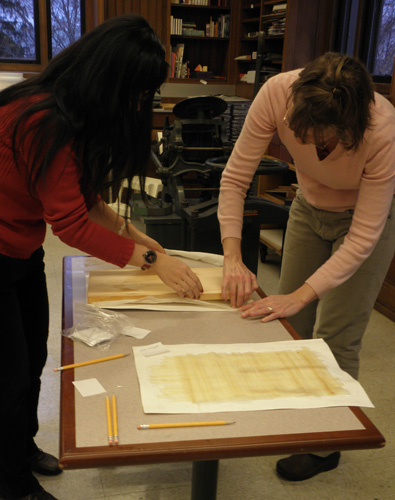
A finished piece of papyrus made from imported Egyptian papyrus fiber. Note the natural tendency of the material to curl--a demonstration of the logic inherent in making scrolls from sheets of papyrus glued together.
History is not dead or forgotten, merely past– that is, for most people. But in our work in the Book Arts Lab, we travel through time on a daily basis. One day we may replicate a woodcut from a fifteenth-century herbal; the next we might work with wood type manufactured in the nineteenth century. We may print a broadside on paper that we made according to seventeenth-century techniques, or bind books as they did in the high Middle Ages. We do occasionally foray into more modern concepts, like the recent zine workshop, but on the whole the Book Arts Lab is a bit like the Tardis– happily travelling through time.
On a recent Wednesday, though, we took a trip considerably farther back in history– to ancient Egypt via a papyrus-making workshop. During the preparation of the papyrus, I learned three facts: papyrus is acid-free, which is one reason that it survives so well; papyrus is not a paper, but a proto-paper; and papyrus is incredibly labor intensive to make.
This workshop–a collaboration between the Book Arts Program, the Classical Studies department, and the Classics Club–has been in the works since early October. That was when we placed the order for processed papyrus on the website kingtutshop.com, and when the Margaret C. Ferguson Greenhouses began fertilizing their papyrus plant. Our plan for the workshop was to use a combination of both locally grown and imported Egyptian papyrus fibers. In the first week of November, the order from Egypt was delivered, and Kristina Jones, Director of the Wellesley College Botanic Gardens, also arrived from the Greenhouses, carrying seven stalks of papyrus, each over seven-feet tall! Beatrice Denham, my co-worker, said that the stalks looked like something out of a Dr. Seuss book, and by the look of the decapitated tops I can’t but agree.
Though all that the Egyptian papyrus required was a long soak in cold water and some rolling, the local papyrus needed a lot more attention. First, we cut the stalks into four- and six- inch segments, stripped off the outer green rind, and then sliced the white interior into fine strips. We then rolled out the strips individually and placed them in cold water. We repeated this step over the course of two weeks to get the papyrus supple enough to work with. By the afternoon of the workshop, the countertops were covered in rolling pins, cotton cloths, towels, wooden boards, and buckets of papyrus, ready for enthusiastic participants and visitors.
To form a sheet of papyrus, we first laid out the longer strips on cotton cloth placed over a wooden board, with each strip barely overlapping its neighbor. Then we repeated that step with the shorter strips, laying them perpendicularly over the longer strips. As you can imagine, it’s quite wet and stringy work.
Next, we took another cotton sheet, covered the papyrus, and rolled out the excess water. This not only dehydrates the papyrus, but also re-enforces the bonds between the strips.
We then gently peeled off the top layer of cotton, transferred the papyrus sheet to a piece of blotting paper, and sandwiched them between pieces of acid-free cardboard.
Once there was a stack of papyrus sheets, we placed them in a standing press, which allowed the sheets to dry under pressure. We changed the soaked blotting paper every few days, and after Thanksgiving break some sheets of papyrus proto-paper were ready to write on– just in time for finals!
Valentina S. Grub ’12 is a double major in Classical Civilization and Medieval and Renaissance Studies and a student employee in the Book Arts Lab.



